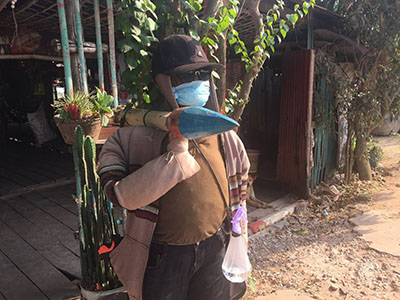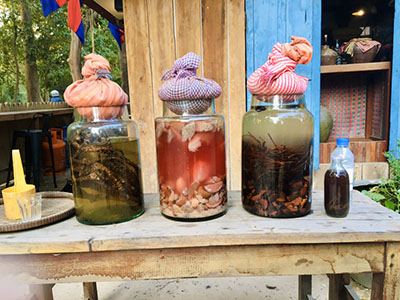Editor’s note: This post is the first in our five-part series “COVID-19: Views from the Field.” Click here to read an introduction written by series organizer Rebekah Ciribassi.
When I waved goodbye to my partner at Torino Caselle Airport in northern Italy on February 18th, 2020, I had no idea what was about to happen—people don’t tend to predict the eves of global pandemics. There were no particularly ominous signs to note, and I was heavily focused on the logistics of carrying out my PhD fieldwork in Cambodia. My research focuses on seasonal variations of the use and consumption of traditional Khmer medicinal plants during maternity by rural women living in Siem Reap Province, Cambodia. My aim is to identify medicinal plants used during different stages of pregnancy, how these medicinal plants are prepared as (or paired with) foods, and what the perceived effects of these traditional food-medicines have on treating symptoms associated with different stages of maternity. In addition to this, I’m also interested in the contemporary role and trajectory of Traditional Khmer Medicine (TKM) within rural community settings and how such traditional knowledge is shared. The overarching goal of this research was to support botanical work being done by the National Herbarium of Cambodia at the Royal University of Phnom Penh, nutrition and dietary research by the NGO Helen Keller International, as well as expand the inter-disciplinary cultural research by the Center for Khmer Studies in my role as a senior research fellow.
As I proceeded to conduct interviews in various villages in Siem Reap province during the last week of February, I noticed changes in the environments and people around me. The large tourist groups that once populated the streets along my commute towards villages surrounding Angkor Wat thinned immensely, leaving all those working in the tourism, transport, and hospitality industries to scroll through their social media accounts on their smartphones as they awaited work. Nearly everyone donned a type of facemask (medical-grade or fabric), schools were closed, and public events and gatherings were cancelled. Various ting mong, or traditional Khmer scarecrows sometimes used to ward off illness, began to appear in front of homes and businesses wearing facial masks.

A Ting Mong, (illness effigy/scarecrow) with mask. Photo by author
I received emails from the U.S. embassy warning me of potential harassment by local Khmer people because of associations with foreigners being carriers of COVID-19. As of April 9th, 2020, 98 of the 119 reported cases of COVID-19 were linked to tourism or recent international travel[i], prompting varying levels of distrust towards barang or “foreigners” by some individuals. While I am half-Khmer, this message of caution concerning potential discrimination was echoed to me by members of my research team as well as my Khmer language tutors; it was very difficult to process because of the uncertainty of how I would be received by members of the communities I would try to interview in unfamiliar rural villages.
Although life as I knew it proceeded to slow down if not stop altogether, I continued my data collection process with additional precautions as well as questions that would garner conversations about COVID-19. With a notebook, digital recorder, facemask, and surplus of hand sanitizer, I interviewed people living villages in rural areas of Siem Reap province. In addition to topics of my own research, I also asked villagers about their knowledge of COVID-19, where they heard about COVID-19, and what “cures” for COVID-19 they’ve heard about, if any. While the U.S. embassy and my affiliates stressed the precariousness of conducting fieldwork at this time, I conducted risk assessments on a day-by-day basis.
It is important to note that a medical pluralism exists in Cambodia, meaning that “in any one community, patients and their carers may resort to different kinds of therapies, even where these have mutually incompatible explanations for the disorder[ii].” In Cambodia, the two main health systems are western biomedicine in the form of public health infrastructure led by the Ministry of Health (MOH) and Traditional Khmer Medicine (TKM). While the MOH reported that Cambodians overall tend to prefer using private biomedical services in the form of private hospitals, clinics, and pharmacies, populations in remote rural areas tend to use TKM as their first, if not only form of healthcare[iii]. Many studies have cited common barriers to accessing biomedicine were most often related to lack of money, proximity to treatment facilities, and the inability to secure a support network while receiving treatment which are more prevalent among rural populations[iv]. What makes studying COVID-19 in a Cambodian context so interesting is being able to discuss which health system people are leaning towards during a time of uncertainty. While symptoms and illnesses involved with maternity may have specific treatment regimens within both biomedicine and TKM, COVID-19’s novelty has made populations seemingly more open to all forms of treatment, regardless of whether they are biomedical or traditional. One of the guiding elements of my PhD research is to understand how individuals make decisions about whether to use biomedicine versus TKM during maternity; COVID-19 gave me a chance to observe and understand how Cambodians actively weigh both medical systems.
The villages I worked in were rural areas which surround Siem Reap City, in northwestern Siem Reap Province, Cambodia. These areas have large wealth gaps; with some villagers relying purely on farming and others on the tourism and hospitality industry. Despite the relative ease of moving between rural and urban areas, travel into the city limits for biomedical treatment is a process of endurance because of long waiting times and financial cost. Many of the villages were near Angkor Archaeological Park, an area protected under the Apsara National Authority of Cambodia and locally perceived as a hub of natural resources. Approximately 67% of households in Cambodia forage for and gather “natural products” for a variety of uses[v], which include TKM use. The proximity to the park granted the possibility of finding people who may have a stronger connection with TKM use due to the abundance of surrounding flora, all while being within driving distance of Siem Reap City and its biomedical facilities. Due to the availability of both systems, several interviewees cited using both biomedicine and TKM to treat any illnesses they experienced. They based their choice of treatment on how “intense” they viewed the illness; citing that biomedicine was to be used if you are “really [strongly]” sick and TKM to be used if you were only “a little” sick. Although interviewees mentioned using treatments from both systems, there was a consensus on not mixing the medicines prescribed by using them at the same time. Rather, individuals would take the biomedicine first and follow it up with TKM regiments.

Khmer Traditional Medicine wine. Photo by author.
Knowledge-wise, all interviewed villagers, regardless of age, gender, education level, and socioeconomic background, had knowledge of COVID-19, its symptoms, and methods of transmission. Most cited local television, Facebook, or YouTube as their primary sources for all COVID-19 information and updates. The MOH stressed the virulence of the disease and its impact around the world; advocating for the practice of better handwashing practices, social distancing, and the closure of public venues and events which may garner large amounts of people. In the event an individual suspected they have COVID-19, they’re told to call an emergency number and are then transported to one of the identified provincial rural hospitals for testing.
While there was an overwhelming preference for using biomedicine for treatment in the event they caught the virus, especially among younger couples with children, several people mentioned that TKM could be used to alleviate many COVID-19 symptoms. As one interviewee explained, “Coronavirus is just a mixture of issues we already know how to cure with TKM.” Although one traditional healer prescribed a three-step treatment plan, most commonly proposed COVID-19 preventative measures or cures included the following elements as either tablets or decoctions with hot water: turmeric, ginger, lemon, salt, and garlic. What was most interesting was that even in the context of a novel virus, TKM maintained a role in healthcare, even for people who did not prefer it. While people actively denounced TKM with respect to COVID-19, they were still taking note and consideration of its potential to help heal them while biomedicine searched for a scientifically backed solution. There was a definitive disconnect between what interviewees felt in theory versus what they actively practiced as it related to understanding and approaching COVID-19. It seems that COVID-19 was able to foster the conditions to generate this type of reaction because despite its novelty, many of the symptoms of the disease have been widely treated using TKM. This familiarity maybe garnered more trust in the efficacy of TKM in handling the virus.
An important, if not essential skill in fieldwork, is the ability to be flexible. Before arriving in Cambodia, one of my supervisors stressed that I should consider the possibility of things not going as planned. The COVID-19 pandemic has been the epitome of everything “going wrong” in the field; I’ve been effectively stranded in my field site without any word about proceeding further. Although COVID-19 has disrupted my plans for research as I initially understood them, it has given me new opportunities to capture unprecedented circumstances as they relate to the usage of biomedicine and TKM. Without the shifts and turbulence posed by COVID-19, I would never have been able to witness the creation and reworking of TKM cures to address newer diseases like COVID-19. One TKM healer I interviewed commented that COVID-19 is a “disease of the unhygienic” and that simple behavioural changes coupled with immunity-boosting TKM remedies would be enough. Treating COVID-19 with TKM seemed to be more about dissecting the individual symptoms and curing them with known medicines rather than developing completely new ones, which forced healers to re-orient their healing repertoires. While the TKM cures were familiar, their applications towards COVID-19 were unique. These observations have contradicted recent reports of TKM’s slowing use in Cambodia by demonstrating the importance of how circumstances may shape individual health decisions for Cambodians of numerous backgrounds.
*Khmer translation provided by Pich Darinah Leang, a senior in the departments of Tourism and International Studies in the Royal University of Phnom Penh.*
References
[i] https://www.khmertimeskh.com/50711253/cambodia-covid-19-case-breakdown-09-april-2020/
[ii] Hsu, E. 2008. “Medical Pluralism.” International Encyclopedia of Public Health, January 316–21. https://doi.org/10.1016/B978-012373960-5.00147-7.
[iii] National Institute of Statistics, Directorate General for Health, and ICF International. 2015. “Cambodia Demographic and Health Survey 2014.” National Institute of Statistics, Directorate General for Health, and ICF International. www.nis.gov.kh.
[iv] Matusoka, Sadatoshi, Hirotsugu Aiga, Lon Chan Rasmey, Tung Rathavy, and Akiko Okitsu. 2010. “Perceived Barriers to Utilization of Maternal Health Services in Rural Cambodia.” Health Policy.
[v] World Food Programme, Cambodia. 2017. “Fill the Nutrient Gap Analysis Cambodia: Rationale and Key Findings.” World Food Programme.

3 Comments
I have just finished reading your notes from the field in Cambodia in the midst of Covid-19, and want to respond by saying that I am fascinated by your findings, your writing, and your subject, and look forward to the final discussion among the 5 participants at the end of the series.
Here in western Ma. where I find myself quarantined for the last 5 weeks, and part of a health care staff for a community of adults with disabilities, amidst the scarcity of testing for Covid-19, we are seeking alternatives which we hope can strengthen immune systems in the meantime. What is striking to me is that we also turn to those same herbal remedies, using them in tea form, that you describe in use there in more rural populations in NW Cambodia!
I very much appreciate your insights and observations. You are in a rare and unique circumstance, and I thank you for your continued perserverence in your research there.
Hello Ashley
You may be interested by Khmer traditional medicine as recorded in an old medical manuscript.
Enjoy the reading
Prof Rethy Chhem
Former CDRI Trustee
https://www.academia.edu/7227530/A_Khmer_Medical_Text_The_Treatment_of_the_Four_Diseases_Manuscript
*Former CKS Trustee
(Not CDRI)
1 Trackback